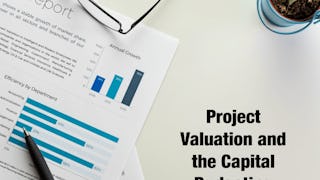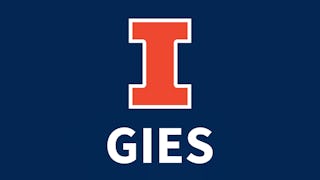This course discusses how public projects are evaluated using cost-benefit analysis. Learners discover how interest rates and prices for stocks and bonds are determined. Techniques are presented on how to create departmental budgets for engineering cost centers and pro forma statements for profit centers. Learners then work with corporate financial statements to assess a company’s financial health, including recent measures of environmental, social, and corporate governance (ESG).

Enjoy unlimited growth with a year of Coursera Plus for $199 (regularly $399). Save now.

Financial Forecasting and Reporting
This course is part of Finance for Technical Managers Specialization

Instructor: Michael J. Readey, Ph.D.
10,067 already enrolled
Included with
(76 reviews)
Recommended experience
What you'll learn
Read an income statement, balance sheet, and statement of cash flows and calculate relevant ratios to determine the financial health of a company
Learn to read and prepare an operating and financial budget, resulting in a pro forma financial statement
Apply scenario and sensitivity analysis to a project’s cash flows
Learn to read and interpret a company’s Corporate Sustainability Report
Skills you'll gain
Details to know

Add to your LinkedIn profile
7 assignments
See how employees at top companies are mastering in-demand skills

Build your subject-matter expertise
- Learn new concepts from industry experts
- Gain a foundational understanding of a subject or tool
- Develop job-relevant skills with hands-on projects
- Earn a shareable career certificate

There are 5 modules in this course
Investment decisions are often based on a company’s financial performance, and such performance is captured in its financial statements. The three examined in this course are the income statement, the balance sheet, and the statement of cash flows. Collectively, these provide a clear picture of a company’s profitability, its net worth, and how it manages its cash.
What's included
10 videos3 readings2 assignments1 discussion prompt
Financial statements inform management and investors about a company’s financial performance in absolute terms – dollars and cents. But it is often more valuable to understand performance in relative terms, such as gross profit relative to revenues, measured as a percentage. This makes it easier for management to compare one year to another and for investors to compare one company to another. Ratio analysis is the way this is done, and there are several categories of ratios that measure a company's liquidity, profitability, debt management, and investment potential.
What's included
9 videos1 reading1 assignment1 peer review
Technical Managers are often tasked with preparing an annual budget for their project team, department, or product line. This involves estimating future costs, and in the case of a profit center, forecasting future revenues. Such forecasts can be made more reliable through a combination of qualitative and quantitative techniques.
What's included
7 videos1 assignment
Forecasting future revenues and costs for a project invariably involves uncertainty, and such uncertainty equates to financial risk - the greater the uncertainty, the greater the risk. Risk management is about mitigating financial risk by assessing a project’s valuation under a range of different conditions, identifying the variables that most contribute to risk, and creating a plan to minimize the likelihood of any financial downside.
What's included
6 videos1 reading1 assignment
Sustainability has become an important consideration in how businesses operate and govern themselves. Managers today focus on their company’s Triple Bottom Line: measuring environmental and social impacts along with their financial performance. Investors are interested in this too, and in response, companies with sustainability as a strategic objective now report their non-financial performance – enabling investors to assess progress toward sustainability goals.
What's included
8 videos2 readings2 assignments
Earn a career certificate
Add this credential to your LinkedIn profile, resume, or CV. Share it on social media and in your performance review.
Build toward a degree
This course is part of the following degree program(s) offered by University of Colorado Boulder. If you are admitted and enroll, your completed coursework may count toward your degree learning and your progress can transfer with you.¹
Instructor

Offered by
Explore more from Leadership and Management
 Status: Free Trial
Status: Free TrialUniversity of Colorado Boulder
 Status: Preview
Status: PreviewUniversity of Illinois Urbana-Champaign
 Status: Free Trial
Status: Free Trial Status: Free Trial
Status: Free TrialUniversity of Illinois Urbana-Champaign
Why people choose Coursera for their career




Learner reviews
76 reviews
- 5 stars
89.47%
- 4 stars
6.57%
- 3 stars
1.31%
- 2 stars
1.31%
- 1 star
1.31%
Showing 3 of 76
Reviewed on Apr 1, 2023
This was a very good course, the professor really knows his stuff. His explanations were thorough, and his teaching style made it a breeze to study and understand.
Reviewed on Mar 23, 2023
Great course with good structure and a pleasant instructor.
Reviewed on Oct 19, 2023
Peer evaluation process consume more time. which is not satisfying
Frequently asked questions
To access the course materials, assignments and to earn a Certificate, you will need to purchase the Certificate experience when you enroll in a course. You can try a Free Trial instead, or apply for Financial Aid. The course may offer 'Full Course, No Certificate' instead. This option lets you see all course materials, submit required assessments, and get a final grade. This also means that you will not be able to purchase a Certificate experience.
When you enroll in the course, you get access to all of the courses in the Specialization, and you earn a certificate when you complete the work. Your electronic Certificate will be added to your Accomplishments page - from there, you can print your Certificate or add it to your LinkedIn profile.
Yes. In select learning programs, you can apply for financial aid or a scholarship if you can’t afford the enrollment fee. If fin aid or scholarship is available for your learning program selection, you’ll find a link to apply on the description page.
More questions
Financial aid available,





